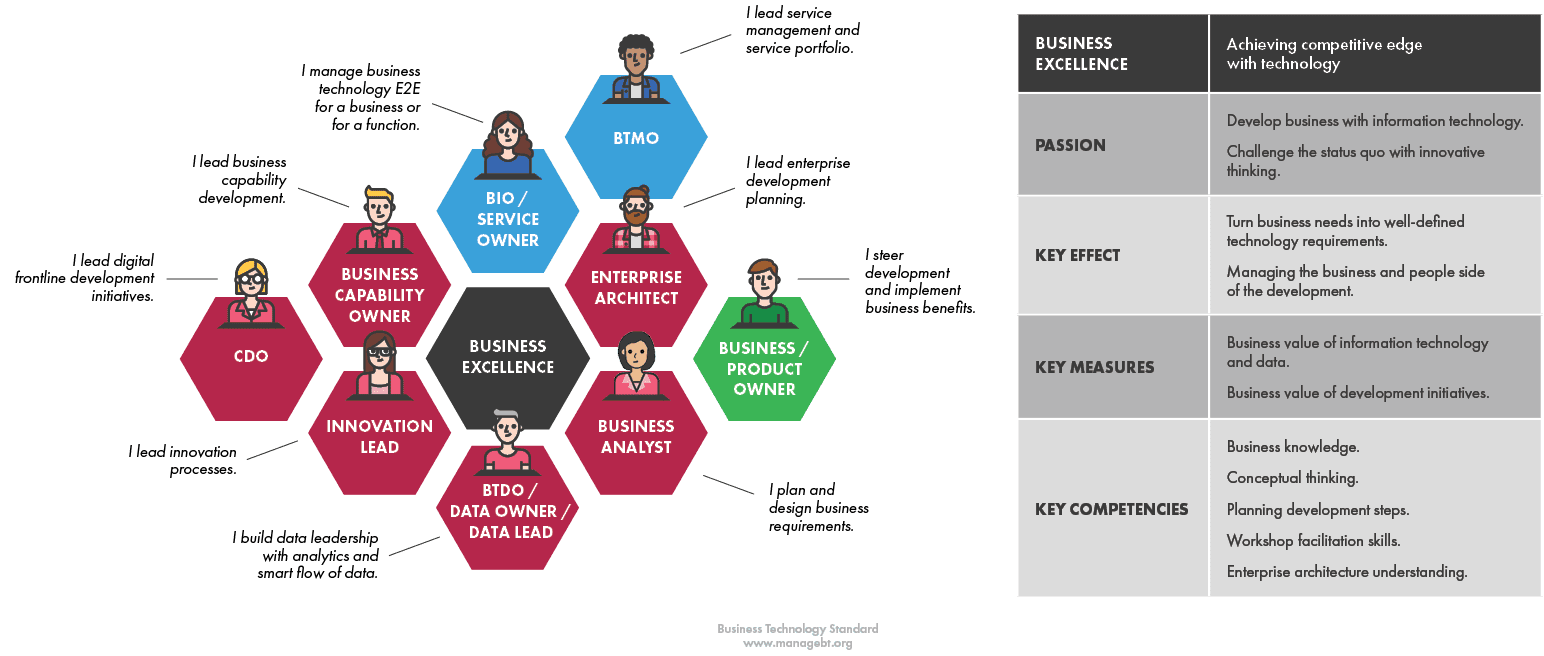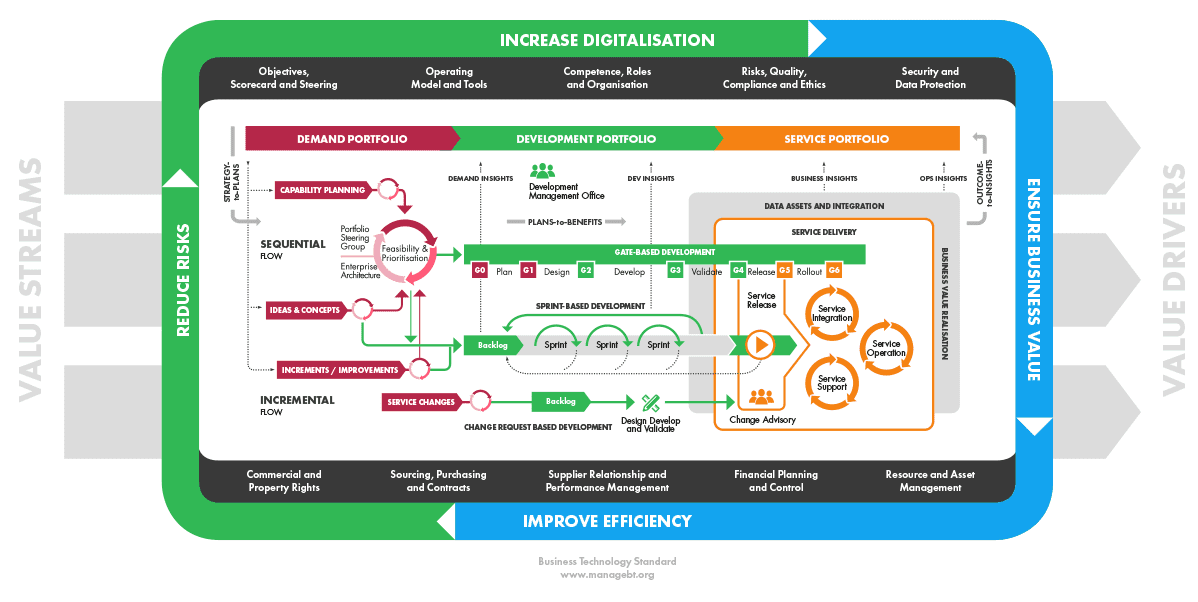Business Technology Standard defines unified roles across business and technology management functions. The aim is to abolish the traditional division between technology management functions and business, and thus enable a seamless and fast end-to-end development of services.
Successful implementation of the business technology principles requires building the cross-functional capability to carry out the tasks and responsibilities regardless of formal organisational functions and reporting lines.
The required competence is achieved by defining the knowledge, skills and experience in each business technology role and making sure that the people working in those roles understand what the expectations for the role are and how they can best co-operate with other roles.
In the business technology context, the traditional gap between people working either in business or in technology management is broken by forming teams consisting of people from different organisations. The teams consist of people sharing the same professional identity. Professional identity defines the characteristics and competencies specific to a group of people who, by working as a team, ensure the successful execution of the duties within a given identity area. The different identity groups together ensure that the business technology function can meet the expectations set by the business.
The picture below outlines the main roles in the business technology function organised around the five identities: business excellence, business and process development, product and service development, service excellence and smart governance.
Figure 3.3.1 Business Technology Standard roles and responsibilities model
Besides the personal knowledge and skills, the identity also considers the motivational aspects of a person, for example, social identity, personal interest and passion. The aim is to encourage people to find and use their strengths and to promote the feeling of achievement. For example, a person working in the service excellence area takes pride in ensuring that the existing services are up-to-date, reliable and stable, whereas another person in the same area prefers the challenge of having to come up fast with an idea on how to ensure the scalability and robustness for a completely new service.
Business technology roles are assigned to different teams based on their identities. The idea is to combine the roles in such a way that the team has the capability to carry out the end-to-end tasks within the scope of the team. In the case of product and service development identity, for example, the team consists of roles like:
The next paragraphs illustrate the key roles within each identity and their key characteristics.

Figure 3.3.2 Business excellence identity roles and key characteristics
The purpose of the business excellence identity is to build a competitive advantage with information technology. Ideally, the team is built with people who are excited by experimenting with the unknown and seeing technology as an opportunity to create something new.
Figure 3.3.3 Business and process development identity roles and key characteristics
The purpose of the business and process development identity is to ensure that the business has the best fit-for-purpose solutions. Ideally, the team is built with people who take pride in succeeding to manage the dependencies of multiple projects and transformational programmes.
Figure 3.3.4 Product and service development identity roles and key characteristics
The purpose of product and service development identity is to ensure that the company is constantly looking for and developing new digital services to remain competitive in the marketplace. Ideally, the team is built with visionary people who enjoy fast-paced development sprints and are continuously challenged.
Figure 3.3.5 Service excellence identity roles and key characteristics
The purpose of the service excellence identity is to ensure that the services are maintained, secure and run without interruption 24/7. Ideally, the team is built for people who focus on securing business continuity. They are constantly seeking ways to streamline and automate the processes utilising the latest operational technology.
Figure 3.3.6 Smart governance identity roles and key characteristics
The purpose of the smart governance identity is to ensure that the operating and governance models, as well as the decision-making bodies, are reaching the company’s strategic goals. In addition, the roles taking care of end-to-end service management and sourcing are included in this identity. Ideally, the team is built with people who have a thorough understanding of both the business imperatives as well as opportunities provided by the technology.
Business technology organisational structure reflects the value creation stream principles set in the operating model (plan/build/run) as shown in the illustration below:
Figure 3.3.7 Business technology organisation
An alternative way to organise business technology is to have end-to-end responsibility for value streams. In these cases, value streams are often called tribes according to the agile terminology. In many cases, the tribes still utilize the common infrastructure services such as networks and computing capacity.
Figure 3.3.8 Alternative business technology organisation
The Chief Information Officer (CIO) is the head of the business technology organisation and has the overall responsibility for the business value of information technology. The CIO leads the strategic planning and sets targets and objectives for the business technology organisation.
The Business Technology Governance Officer (BTGO) leads all governance functions and ensures that the guidance, instructions and controls are effective.
The Business Technology Management Officer (BTMO) has the end-to-end accountability for service planning, management and performance and they ensure the business continuity and business value of services together with service owners.
The Chief Digital Officer (CDO) leads the digital frontline development initiatives and drives and executes the organisation’s digital agenda together with Innovation and DEV Leads.
The Business Information Officer (BIO) has the end-to-end business benefits accountability and ensures the business value of the information technology with help of the service owners.
The Business Technology Data Officer (BTDO) builds the data integration and analytics capabilities for the business and takes care of improving and maintaining the business value of the data.
The Business Technology Portfolio/Programme Officer (BTPO) manages the business and process development capability and portfolio and leads the Development Management Office (DMO).
The Business Technology Solution Officer (BTSO) has top-down accountability for all solutions and solution development.
The Business Technology Operations Officer (BTOO) ensures business continuity and delivery performance in service operations.
